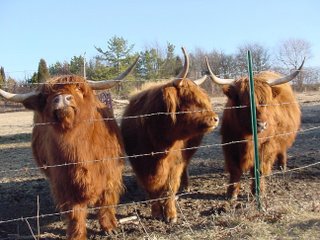How much do you really know about yaks?
 (Reprinted from the Portsmouth Abbey Beacon, February 27, 2002)
(Reprinted from the Portsmouth Abbey Beacon, February 27, 2002)Across Portsmouth Abbey, speculation is rife concerning the strange, foul-smelling creatures behind the Stillman Dining Hall. They are not yaks, as many ignorant people believe. Though they resemble these worthy animals in appearance, and in their strange fascination with cornbread, the true Himalayan yak is never found at low altitudes, preferring the health benefits of the rarified mountain air. Nor are they Scottish Highland cattle, as many supposedly “educated” people claim. For one thing, their accent is Lowland Scottish, distinguished by shorter vowels, simpler diphthongs, and a vibrating “r” sound.
Our own Matt Papi and Justin Bauer have just spent a term as Community Service interns studying these remarkable and fascinating animals. It is especially fitting that our Community Service program has taken the first step towards dialogue between students and yaks, for dialogue is the first step towards understanding. Although complete understanding has not yet been reached- our custom of Morning Lunch is as incomprehensible to them as their obsession with backgammon is to us- nevertheless we have learned much about these wonderful creatures, and hopefully they have learned much about us as well.
What do yaks like to do in their free time? Besides backgammon, at which they excel, they enjoy cornbread and reruns of “Star Trek.” Some time ago they were successfully introduced to the multi-player computer game “Half-Life”, and proved quite adept at it, but they have since been barred from the Computer Lab for trying to download inappropriate material from the Internet. Their strong competitive instinct has allowed them to dominate in pick-up soccer games and Ultimate Frisbee against Abbey students, and they are sometimes seen playing one-on-one basketball in the gym. For relaxation, they like to listen to ethnic Albanian music which causes them to fall into a hypnotic state.
There is one question concerning the yaks that is surely on everyone’s mind. Are they being raised for mystery meat? The answer is certainly no. Yak meat is easily identified by its chewy consistency and savory aroma when grilled, and is widely prized as a delicacy. It cannot be considered “mystery meat” except in parts of
What to do if you ever encounter a yak in an unexpected place such as the library or an elevator: Most importantly, do not attempt to solicit the assistance of bystanders. You are probably doomed, and yelling for help will only endanger the lives of others. If you are lucky, you can hold the yak off long enough for everyone else to escape. Do not panic. Yaks respect bravery in a victim. If you know a little Latin, now would be a good time to use it. “Morituri te salutant” is the customary formula in such situations.
Beneath their gruff exterior, yaks are gentle and fun-loving creatures. In fact, they seldom attack unless provoked. Some might even argue that they are the Abbey’s greatest asset, although most would reserve that honor for General Tso’s Chicken. Many students are totally dependent on these animals for meat, clothing, transportation, and yak butter tea. Its hair is woven into rugs and blankets to protect against the frigid







